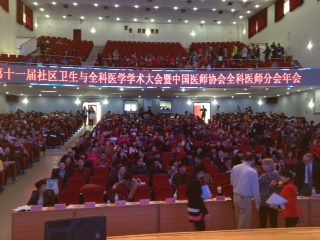From the President: China and the rise of the family doctor
 Photo: WONCA president with family medicine residents and staff of the General Practice Training Program at Central South University in Changsha
español
Photo: WONCA president with family medicine residents and staff of the General Practice Training Program at Central South University in Changsha
español

Dr Yin Shoulong is a rural general practitioner, in Tai Shitun Village, in China. He lives in a typical rural village house built around a central courtyard, with his clinic occupying one side of his home. His patients are from his farming community and many are impoverished and elderly and frail.
Photo: Dr Yin Shoulong, rural general practitioner, in his clinic in Tai Shitun Village in the Mi Yun District north of Beijing
Tai Shitun is in the Mi Yun District, two hours drive north of Beijing and a very different world from the densely populated metropolis to the south.
Dr Yin has devoted his career to supporting the health and well being of the people of his village and the surrounding district. Recently he has become involved in providing experience in rural medicine to young family medicine trainees on rotation from the Capital Medical University in Beijing. He is part of the primary care revolution underway across China.
This month, I have been traveling in China, visiting family medicine training programs in Beijing, Shanghai and Changsha, as well as teaching clinics in urban and rural areas.
The Chinese health system, like that in many other countries, is facing many serious challenges including an ageing population, increasing prevalence of chronic diseases and mental health problems, and escalating use of expensive hospital services. Problems are compounded in

the world’s most populous nation, by the significant disparities between the health services available to people living in major cities, compared to those living in rural areas.
Photo:
Traditional Chinese Medicine pharmacy in the Community Health Clinic of
the Miyun People’s Second Hospital in the regional centre of Miyun
In 2009, the Central Government of China launched its comprehensive health system reform with the strategic goal of “Healthy China 2020”. The reforms aim to strengthen primary care nationwide to ensure accessible, affordable and equitable health services for over 1.3 billion people by 2020, and to reinforce the importance of general practice/family medicine as a core part of the health care system.
The health care reforms underway in China are extraordinary and are based on building and strengthening the family medicine workforce, through education and training and a focus on quality care. The aim is to ensure that every person in China, no matter where they live, has access to high quality primary care delivered by a trained family doctor.
China’s government has set a goal of training 400,000 general practitioners by 2020. This involves a combination of training large numbers of recent medical graduates to become family doctors, training experienced doctors to work as family doctors, and upskilling the existing community-based medical workforce in both rural and urban areas.
 Photo
Photo:
900 family doctors from around China participated in the 11th
Scientific Conference of General Practice and Community Health of the
Chinese Medical Doctor Association’s General Practitioner’s
Sub-association, held at Capital Medical University in Beijing
WONCA has been supporting the development of family medicine in China since its introduction in the 1980s. We have done this especially through our work with our member organization in China, the Chinese Medical Association College of General Practitioners, and our work in partnership with pioneering family medicine training programs at leading institutions like the Capital Medical University in Beijing and the Shanghai Medical College, at Fudan University.
These institutions and many others across the country are now moving the training of family doctors out of major teaching hospitals and into community health centres. There is increasing recognition that the training of future family doctors needs to be based in the community – with trainees working as members of primary care teams, and with the majority of training provided by family doctors.


Photo (left): Clinical simulation centre of the General Practice Structured
Vocational Training Program of the Shanghai Medical College at the
Zhongshan Hospital of Fudan University, supported by the Shanghai
Municipal Commission of Health and Family Planning
Photo (right): Family medicine training clinic at the Kangjian Community Health Centre in Shanghai
There are some significant barriers to overcome. There is a strong belief among many members of the community in China that the best medical care is available through large hospitals. Many people have experienced poorly staffed and inadequately resourced community clinics in the past. The new generation of community health centre based family doctors is working hard to earn the trust of their local communities and the word about the improvements in the quality of care provided is spreading fast.
Many recent medical graduates are uncertain about the viability of a career as a family doctor. Career structures and opportunities for career progression are much more visible in teaching hospitals and local governments are having to develop new ways of attracting and retaining medical graduates to become family doctors.
The reforms underway in China will have implications for the rest of the world, and especially for those countries where family medicine is not yet well established. One of the biggest challenges is training the family doctor workforce to meet the needs of rural China. If the rural challenges can be met with success, then this should provide lessons that will flow to many other parts of the world facing the challenge of providing universal health coverage.
Michael Kidd
WONCA President